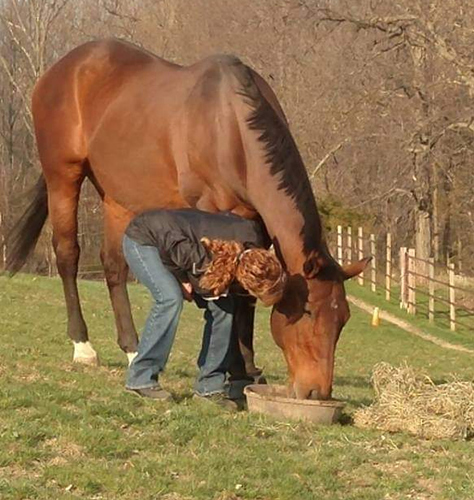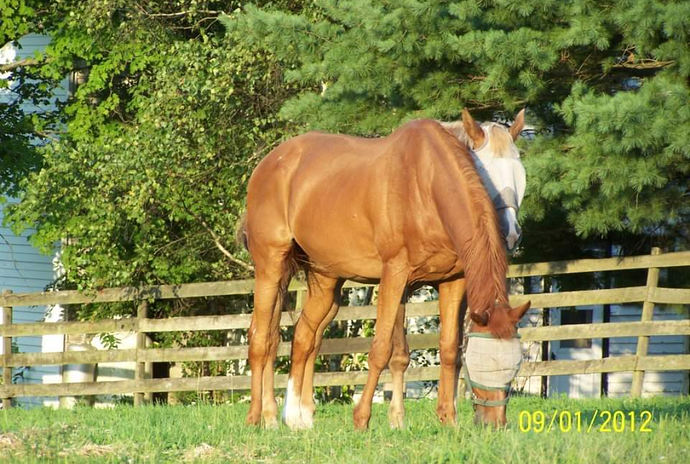@DaveYGunN it’s been a couple months since you’ve checked in, how are Bonnie, Honey and the Donkey doing?
Excellent update, do keep em coming when you can. Many of us do horses vicariously now that we’re old and broke/n.
That pad is a great color for her
Are those cavaletti poles behind her too, that she’s working on?
She looks better than before but IMO she needs more weight. I mean, I have had a few horses that were always on the lean side of life so I get it, but they had more fat pads behind their shoulders and along the tail head. One always had a spine like a razor (build) but had more padding over the ribs.
She’s not an air fern. Any chance of getting a high quality senior feed into her? If she has ulcers, the Triple Crown Senior Active+ is extruded and that may be an excellent choice for her.
Her pasture mate probably doesn’t need it and you’ll have to give her more time to eat simply due to her caloric needs being so much higher.
Definitely looking better, but with room for improvement.
I agree Thoroughbreds do
Require more food to gain
Weight.
I would suspect ulcers or even
Still having left over parasites.
Are the round bales good quality
Hay or just for boredom eating?
Daughter sure looks happy.
You are a GREAT Dad!!!
There’s definitely still room for improvement.
These things do take time, but with winter coming, it might be time to up your game before you get too far behind because staying warm burns calories she needs elsewhere
If it were me, and I had stalls (I believe you do), I’d stall at night to get them out of the cold (which burns calories) and feed her a bit of an extra third meal to boost her.
Examples of extra feed would be one or all of the below :
A flake of alfalfa in top of good grass hay
A serving of warm water soaked alfalfa pellets or cubes with beet pulp (always serve soaked)
A scoop of cool cals or similar fat supplement
Just for comparison:
My second horse, a TB, at 19
And my first horse, also a tb, at aged 27
Plus if they eat their meals in their own stalls in the morning and at night, you know for sure each one is getting their intended food ration.
Their little girl looks thrilled to bits. She must be having the time of her life with them. 
Thanks for the update!
I know your questions are coming from the right place, but please don’t set a fire in your barn 



NO to a wood stove in a barn.
Besides CO2, the chance of fire
Is too great.
Do you have doors to close up the barn?
Hay. You learn a lot from the horses telling you what they like or don’t like.
Visual- does it look and smell fresh? Or moldy or dusty (pre-moldy)?
Smell it. Some hay has preservatives sprayed on it. May look great but my horses will not eat it. Can’t always smell that stuff but the horses can.
So much also depends if it’s 1st,2nd, or 3rd cut. Here 2nd cut
Is considered the best. Fewer weeds. Less stemmy so more is eaten.
Right now I pay $24.-27. for small 2 string grass or alfalfa bales. But it’s all edible, good hay.
Buying good hay is a crap shoot.
It takes experience and an honest seller to get good hay.
Some sellers test their hay for
Nutritional quality and moisture content.
I’m sure others will chime in.
PS/ here in Fl. Round bales are
Mostly coastal Bermuda grass, good for cows but not for horses.
Absolutely not, fire and barns, combustables like hay and shavings and cobwebs are a never, ever, ever.
Not a cigarette, not a match, not glass shining on a scrap of hay in the sunlight. Ever.
Barn fires are a number one horseman’s nightmare.
Equianalytical/Dairy One is a great place to test their hay. Their reports are easy to interpret once you get the hang of it, and they are fast in their reporting.
Here’s their website with all the basics-they are also great to talk to if you have more questions.
I don’t know the temps where you are, and maybe you’re already doing this, but definitely she should have a rain sheet and a light-weight blanket, or if it gets cold enough, a mid-weight or heavy-weight blanket. In the mid-Atlantic area, the barns I’ve boarded at would blanket according to the weather while the horses were out during the day in winter and take them off when the horses came in to their stalls for the night. It’s generally above 20* most of the winter, so my horse used a mid-weight blanket and on the few days it was colder than that, I had a wool cooler that I could layer underneath the waterproof outer mid-weight blanket.
In summer, horses stayed in during the day to avoid the sun/heat and flies (fans and fly-spray system in the barn), and out at night to graze in the cooler temps. Reversed in winter to be out during the day and in at night, about 12 hours each for both summer and winter.
An elderly horse or a horse that needs to gain/keep weight needs more blanketing than one who has extra poundage or is younger. Some horses grow more coat or may be more sensitive to cold weather. Your horse shouldn’t be sweating much (a little when being active is understandable) when blanketed and just grazing. But I don’t want my horse shivering with ice-cold ears either.
Wet (rain/sleet/drizzle, especially if windy) under 50*/55* and I’ll put a rain sheet on the horse. Under 40-ish and I’ll put a mid-weight blanket on. Under 20*-ish and I’ll put the wool cooler on with the mid-weight over it. If it’s under 15* with an elderly or underweight horse, I might keep the wool cooler on at night while stalled.
It is also important to take whatever blanketing you have on the horse off frequently, preferably daily, to check for rubs, injuries, and to keep an eye on weight loss or gain.
Forgive me if this has already been addressed. Have your horses teeth been looked at/floated? Do they drop grain or quid their hay ? Round bales vary in quality. Many in my area are really not suitable for horses or not conducive to weight gain. The quality is low, stemmy and the nutrition is lacking. What type of roundbales are they? What is the approximate weight and cost?
Ps I do believe you are really trying to learn and take good care of your horses. So this is said with kindness and concern. The one horse in particular is quite skinny. And lacking muscle.
…and lacking muscle.
At her age I’d ask your vet to check for PPID (Cushing’s).
I’d also want to re-check the
Blood regarding the original
Diagnosis of “systemic inflammation”. She may have
Painful arthritis or Insulin resistance.
Just further thoughts to ponder.
So I have one that we about have to force feed to keep weight on him otherwise his body condition dramatically decreases. We have to convince him to keep eating around the clock or he looks like an ASPCA case–and we have scoped for ulcers etc. He is just big (17.2) and has a massive metabolism from the four years he raced.
What has worked for us has been adding 8 pumps of corn oil right on top of his pellet food. Straight up calories. I wish someone told me that’s what I needed in life.
This is in addition to a bucket of soaked alfalfa cubes and unlimited hay and a treat ball. It’s made a HUGE difference in getting the weight to stay on him. If you’ve ruled out ulcers and teeth (which are what I always check first when I need a horse to eat), look at the corn oil.
If I may propose an alternative for keeping the critters warm–
Have you looked at doing heated concrete floors? We do this for our barn in the midwest. The actual set up and installation, if you’re handy and like home projects, is not terribly difficult with another set of competent hands. The electric bills in the winter may make you weep. But it regularly keeps our barn a solid 10 degrees warmer in winter–essential when you’re looking at sub 32 degree temps for weeks on end.
Im just reading this thread for the first time now so forgive me if things have already been addressed.
On the topic of rounds vs squares; I have a VERY easy keeper Fjord. One of the barns we were at used rounds and I was very concerned about him having too much access to hay. He LOST weight while being on the rounds and nearly all of the normal/hard keepers started getting into pretty bad shape. All that to say, don’t assume unlimited access will “fatten them up”. Depending on rain/snow/precipitation, if the rounds don’t get eaten down quickly they will mold, and there is also a risk of botulism. Rounds also are the most wasteful form of hay as well, so while they tend to be less expensive overall, the waste is tremendous. It’s also hard to tell how much a horse is consuming off rounds.
In your case having hard keepers, personally I would be weighing out at least 20 lbs of tested hay to ensure they are being offered the pounds they need per day/getting the nutrition they need and keeping the rounds while out in turnout. Then you know they are at least getting the weight they need to be eating and the rounds will keep their stomachs happy while turned out.
On hay quality, you can tell visually and by smell whether or not the hay is moldy…maturity…things like that, but you can’t eyeball the actual nutrients it contains. Some hay that visually looks like its low quality can have a better nutrient profile than a hay that looks great. Until it’s tested you just dont know.
It also doesn’t look like your horses are on grass either which warrants a good quality Vitamin E supplement; Emcelle, Nano-E, and Elevate are all highly recommended. I personally use Emcelle. You will run into health issues if you have a Vit E deficient horse for too long; grass is where they get it from unless you supplement it. I like the suggestion of something like Triple Crown Senior…sweet feed is basically like Lucky Charms…AKA junk.
Good luck! Your daughter looks like she’s having the time of her life 
And HARD NO on a wood stove or any heating element such as that inside the barn.


